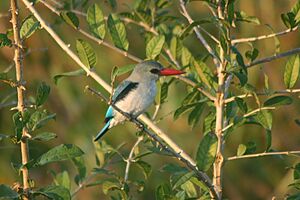Mangrove kingfisher facts for kids
Quick facts for kids Mangrove kingfisher |
|
|---|---|
 |
|
| In Saadani National Park, Tanzania | |
| Conservation status | |
| Scientific classification |
The mangrove kingfisher (Halcyon senegaloides) is a beautiful bird found along the eastern coast of Africa. It's a type of kingfisher, known for its bright colors and sharp beak. This bird lives in different places like woodlands, near rivers, and in areas where rivers meet the sea, called estuaries, and in mangrove forests. It looks a lot like its cousin, the woodland kingfisher. Scientists say it's not currently in danger of disappearing.
Contents
About the Mangrove Kingfisher
Naming and Family
The mangrove kingfisher was first described by a scientist named Andrew Smith in 1834. He studied a bird found near what is now Durban in South Africa. This bird is a close relative of the woodland kingfisher. It belongs to a group of birds called Halcyon kingfishers.
What It Looks Like
The mangrove kingfisher is about 22 centimeters (about 8.5 inches) long. Both male and female birds look very similar. Their heads are dark grey-brown. They have black areas around their eyes and a thin white line just above the eye. Their cheeks and neck sides are grey-brown.
Their chest and sides have wavy, irregular lines, which scientists call "vermiculated." There's a black patch under their wings. The rest of their feathers are black and blue, similar to the woodland kingfisher. The mangrove kingfisher has a bright red beak, dark brown eyes, and dark grey-brown legs.
Young kingfishers, called juveniles, are not as brightly colored. Their wavy lines are rougher, and their chest has a yellowish-buff color. Their beak is brown. Birds living in the southern parts of their range often have slightly longer wings and thinner beaks.
Where It Lives
This kingfisher lives near the eastern coast of Africa. You can find it from Somalia in the north, all the way south through Kenya, Tanzania, and Mozambique, down to South Africa. Sometimes, one might even be seen inland along big rivers like the Jubba and Zambezi rivers.
It usually stays within 20 kilometers (about 12 miles) of the coast. The mangrove kingfisher is a partial migrant, meaning it moves around during different times of the year. When it's not breeding, it likes to live in estuaries and mangrove forests. It also lives in wooded areas, thorny bushes, forests, farms, parks, and gardens.
Reproduction and Life Cycle
When it's time to breed, the mangrove kingfisher moves away from the estuaries and mangroves. It prefers to nest in woodland areas and along wooded rivers, which are usually further inland. However, they do breed in the Zanzibar Archipelago near the coast.
Breeding has been seen from October to January. These birds build their nests in holes in trees or inside termite nests. During their breeding display, they spread their wings.
What It Eats and How It Behaves
The mangrove kingfisher is a skilled hunter. It mostly catches fish. But it also enjoys eating crabs, prawns, lizards, and insects. Its song is a loud, fast series of "tchi" notes.
Conservation Status
The number of mangrove kingfishers seems to be going down. This is mainly because their homes are being lost. However, the decline is not happening very quickly. Also, this species lives across a very large area. Because of this, the International Union for Conservation of Nature (IUCN) has listed it as a least-concern species. This means it is not currently in danger of extinction. Sometimes, young birds flying to new areas can accidentally hit human buildings.


